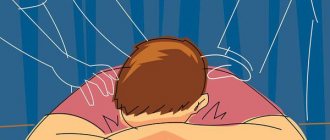Anancastic personality disorder (APD) is a congenital or early acquired character anomaly that interferes with a person’s full adaptation in society and is manifested by pronounced subjective problems due to a person’s tendency to doubt, double-check, obsessive thoughts, etc. If a person is anantcastic, this condition can lead to a decrease in social interaction, financial problems and difficulties in obtaining education.
The main risk factors for developing anancastic personality disorder:
- hereditary predisposition (about 7%);
- age crisis;
- psychotraumatic situation (including facts of physical or mental violence);
- massive hormonal changes;
- excessive psycho-emotional stress;
- persistent stress; and so on.
Anancaste disorder, as a rule, debuts at school age with excessive shyness, constant fear of doing something wrong and worsens when the patient begins to live independently and is forced to bear responsibility for himself and his family.
Types
How can people with anancastic personality disorder be classified? Types of deviations occur at different levels. In psychotic and neurotic, at the same time, the personal characteristics characteristic of this type are preserved in everyone. Some groups of doctors divide anancastic personality disorder into compulsive and obsessive types, others do not.
The obsessive-compulsive character is fundamentally based on such protective mechanisms as “isolation of affect”, in which the emotional component of the experience is leveled out by “reactive formation”, when a negative feeling is transformed into a positive one and vice versa. The person is also convinced that he can completely control all processes - these people are overcome by a mania of total control.
Hysterical psychopathy
In men, the pathology is extremely rare. With this disorder, all emotions and feelings are exaggerated. Characteristic:
- demonstrative behavior;
- theatricality of facial expressions and gestures;
- emotional lability;
- infantilism.
All actions are dictated not by the desire to achieve a certain goal, but by the desire to impress others. Such men are very amorous, but at the same time they quickly become disappointed in their feelings and often change partners. They cannot find a permanent, well-paid job and are irresponsible. Under the influence of any external reasons, hysterical attacks are possible, accompanied by uncontrollable aggression, anger, and rage.
Causes
The most common causes of the disorder include:
- genetic predisposition;
- birth and traumatic brain injuries suffered at an early age;
- mental illness (the disorder often accompanies autism, manic-depressive psychosis, schizophrenia);
- long-term suppressed anxiety or aggression.
According to experts, anancastic personality disorder is formed in children whose families have high demands not only on behavior, but also on emotions. This leads to the fact that the child begins to feel guilty for his inability to control feelings and desires, as well as fear of punishment.
Minuses
Anankast is characterized by an inability to adapt to environmental conditions - rigidity, as well as stubbornness, excessive love of order, laws and rules. This person is obsessed with neatness, goes into the smallest details and sometimes completely insignificant details; he can be called a perfectionist. And all this prevents him from normally completing any of the tasks he undertakes. And they are very afraid of making a mistake, because of this they are indecisive. A person is constantly overcome by “mental chewing gum”: a lot of thinking, but there is no solution to the problem.
Such people are characterized by a high degree of formality, lack of a sense of humor, excessive seriousness, and intolerance.
They are incapable of compromise, but most importantly, they demand from those around them complete submission to the rules of the life they have invented for themselves.
For them, anything that can break familiar stereotypes is alarming and unacceptable, and this anxiety is masked by various rituals. Anankasts often develop completely unacceptable desires.
As a consequence of the disease, people develop anxiety-phobic disorders and obsessive-compulsive neuroses. Is it worth saying that you should consult a psychiatrist for treatment?
Symptoms
Such disorders are characterized by inertia of thinking, stubbornness, excessive fixation of attention on details, and obsessive behavior that occurs periodically.
Obsessive thoughts often concern everyday moments. Patients perceive them as tiring and painful, and they try to resist them. But the thoughts involuntarily return again. Such thoughts lead to attacks of compulsions, which are expressed in obsessive actions in order to prevent adverse consequences. As a rule, such consequences are unlikely.
Sometimes excessive attention to detail takes on a very pronounced form, which interferes with the performance of professional duties and full-fledged life activities. Patients develop their own ideas about quality. They are usually more strict than is customary. In everyday life, a whole system of housekeeping is formed. Moreover, it is difficult to convince a person to change the procedure he has established.
Minimum required information
The term anankast comes from the ancient Greek word meaning coercion.
Painful symptoms manifest themselves in the form of obsessions and compulsions. Obsessions are obsessive states of thinking. Compulsions are obsessive actions as a result of obsessive personality changes.
Anancaste disorder manifests itself in character changes in which common sense and results are often sacrificed to formal ideas of order.
The behavioral reactions of this type of people are determined by the characteristics of their psyche. For every event or object, they try to find its place in the world around them. A person with a painfully pedantic character spends his entire life sorting objects and events into their assigned places. He perceives any deviation from the principles and norms he has established for himself very painfully, since this brings discord into the picture of the world that he has once and for all established for himself.
An anonymous person rarely holds leadership positions, as he does not have flexibility of thinking. Such a person is good where it is necessary to constantly comply with strictly established rules, for example, when checking vehicles before operating them.
Classification and stages of development of anancastic personality disorder
APD begins in childhood or adolescence. Throughout its course, it goes through a number of successive stages, which can be repeated and returned.
The two main phases of personality disorders are:
- compensation;
- decompensation.
During the compensation phase, the features of APD are smoothed out, bring minimal subjective discomfort, and the person is able to get along with them. Often, to achieve this, he adjusts his life accordingly: he creates a safe environment around himself of people who can support him and help him cope with anxieties and difficulties, chooses a job with minimal responsibility (although people with APD can find a reason to worry everywhere), etc. .
The decompensation phase is a period of exacerbation of maladaptive personality traits, increased anxiety, doubt and indecision. This leads to severe subjective discomfort and interferes with full adaptation in society. During these periods, people may experience symptoms of depression from ongoing worry and anxiety, disruption to their relationships, and other social distress.
When should you suspect a disorder?
To suspect anancastic personality disorder, you should pay attention to the following symptoms:
- constant, unnecessary doubts and double-checks, excessive caution;
- excessive preoccupation with details: rules, schedule, organization, subordination, which sometimes harms the process itself;
- a clear focus only on the “ideal” result of the activity or “nothing at all”, perfectionism, which significantly inhibits the mentioned activity;
- over-obligation and over-conscientiousness, which fixates a person on the activity being performed to the detriment of his personal life;
- thoroughness, strict adherence to social norms and orders;
- inability to adapt to a changed situation, stubbornness, panicky reluctance to change the planned plan;
- the requirement to do everything “just like him”, an inexplicable inability to cede part of the work to other people.
The last point is worth considering in a little more detail. The fact is that the anankast is absolutely convinced that he is the only one who performs some type of activity the way it needs to be performed. And it doesn’t matter what it is: drawing up an important financial report or hanging the keys to offices on the nails of the duty officer at the entrance.
Positive traits of a pedant
However, talking about pedants solely in a negative way would be biased. A pedant is a person who loves order, which is assessed positively by society. It is no coincidence that the word “pedant” has a sufficient number of positive synonyms: “neatist”, “literalist”, “precise”.
Pedants and profession
Anankasts integrate well into the team, becoming irreplaceable people in many professions. Moderate pedantry is simply necessary for representatives of such professions as aircraft technicians or automobile repairmen, who are required to repeatedly recheck and revise airplanes or cars to ensure safety. Therefore, if a person is not a pedant, then he should think before choosing this kind of profession.
Pedants in everyday life
Anankasts also demonstrate pedantry in everyday life - they constantly double-check their homework. A pedantic woman (pedantka) is an excellent housewife, in whose house there is cleanliness and order, where everything is cleaned and ironed. True, a pedant’s house usually looks more like a museum, and therefore the atmosphere in it cannot be called cozy, and washing the floors four times a day can tire not only the woman herself, but also all members of the household. However, even a pedantic man is capable of “building” an entire family.
A pedantic woman (pedantka) is an excellent housewife, whose house is clean and orderly.
Pedants are irreplaceable workers
Anankast, working as an accountant, will be a “valuable find” for any company, since all his documentation will be in perfect order, and his balance will be reduced to a penny. Anankasts simply cannot do things “somehow.”
Moderate pedants are serious, thorough people who complete any work assigned to them with high quality and on time. Anankasts are people of duty, conscientious about their duties. These qualities of pedants are highly valued by managers.
Career prospects for pedants
Pedants are formalists and sometimes unbearable bores, but in some professions these qualities cannot be avoided. That’s why anankasts often have excellent careers – they become good high-level managers. Moreover, this may not even happen according to their will.
It’s just that responsible people who perform their duties well often move higher up the career ladder. However, anankast leaders are afraid to make independent responsible decisions and take responsibility for other people.
Cleanliness in everything
In order to better understand who a pedantic person is, it should be noted that we are talking about a neat and tidy person, which is primarily manifested in his appearance: clean and carefully ironed clothes, neat hairstyle, well-polished shoes. Pedants, even when at home, do not allow sloppiness in appearance.
Pedant parents
When it comes to raising children, pedantic people are true to themselves: the established regime cannot be violated, and therefore at the specified time the child must go to the potty, go to bed, and come home from school. However, you should not get the impression that a pedantic person means a bad parent. Pedants are not insensitive individuals, and therefore, like all parents, they love their children and sacrifice themselves for them.
Pedants spare no time in putting things in order; without it, they will start to get nervous
How to avoid making a mistake with a diagnosis?
In order to have confidence in the diagnosis, the sick person must meet certain characteristics, which usually appear already at the initial stage of the formation of personal qualities. When anancaste disorder develops, a person becomes stingy. He is constantly concerned about saving a certain amount for an emergency. This could be a natural disaster, catastrophe, or other reason.
In this situation, a person perceives financial well-being not just as money, but as an opportunity for salvation. It is difficult, almost impossible, to convince such a person and force him to make concessions; he desperately defends his opinion, absolutely confident that he is right.
At work
Watch your boss. If he cannot and does not want to disrupt the algorithm according to which his work proceeds, he has difficulty delegating authority, and demands that everything be strictly done only as he says, you have a possible anankasta in front of you. There are many of them in leadership positions.
At the same time, he is absolutely sure that he is doing everything correctly, this is the only way it should be, there are no more options. He has pens and pencils lined up on his desk, his monitor stands in a strictly certain place without a single speck of dust, and his keyboard lies at a certain angle. The chief anankast will require, for example, that the numbers in the report appear not on the left or in the middle of the column, but strictly on the right. Lack of understanding on the part of colleagues of such subtleties makes the patient with anancastic disorder angry and refuse to work with such “stupid” employees.
Establishing diagnosis
The diagnosis is made based on the analysis of the following psychopathological symptoms:
- constant doubts and anxiety;
- pathological perfectionism;
- painful pedantry;
- excessive detail;
- stubbornness;
- requiring others to comply with its rules;
- suppression of one's own desires for the sake of one's own rules.
It is believed that if a person has at least three of the listed signs, then such a person is anankast.
Clear signs of the disease
In his youth, the future anankast is shy and always overly controls himself. To accurately make such a diagnosis, you need to identify four or more of the following signs that appear as a person matures.
- Excessive attention to details and rules, strict adherence to the plan, often to the detriment of the result and meaning.
- Perfectionism leads to relationship problems.
- Excessive immersion in work at the expense of leisure, even when there is no obvious lack of finances.
- Excessive desire to accumulate money, condemnation of unnecessary spending. Every penny seems wasted.
- Such people do not know how to cooperate with others.
- Inflexibility in all areas.
- Discomfort when changing the familiar environment, any repairs and rearrangements are painful for anankast; he has difficulty parting with old things.
- Emotions are under strict control and often do not appear.
- It is difficult to make contact with new people.
Diagnostics
If we talk about making a diagnosis, this should be done only after appropriate observations of a person’s behavior over a certain period of time. It is advisable to make a diagnosis when a person reaches adulthood, since character traits characteristic of young people in adolescence should also be taken into account.
To make an accurate diagnosis, the following important aspects must be taken into account:
- Manifestations of the disorder must be total and independent of circumstances.
- Stability of symptoms that were observed in adolescence and continue to be present in older age.
- Excessive tendency to doubt, which cannot be confused with a person’s everyday doubts in connection with life circumstances.
- Unreasonable occurrence of persistent thoughts that do not change over time.
- The presence of perfectionism, which prevents the person from achieving the goals and objectives set for him.
Is pedantry good or bad?
Pedantry is a character trait of anankastic people (anankasts), who are often found in Northern Europe, and especially in Germany: everyone knows that the notorious German pedantry implies a character trait - neatness. In Russia, pedants are rare.
The attitude of society towards the character trait under discussion is ambiguous, and therefore the question arises: is pedantry good or bad? There is no one-word answer to this question. If we talk about moderate pedantry, then it can be considered as a positive character trait, which cannot be said about excessive pedantry, which is a vice and the cause of various negative situations and conflicts.
Treatment of anancastic personality disorder
Psychotherapeutic treatment of anancastic personality disorder is aimed at eliminating the anxious and suspicious state and depends on the severity of the disorder and the discomfort caused. Patients accept all methods of psychotherapeutic treatment on a conscious level, but on an unconscious level they show strong resistance.
In severe forms of anancastic personality disorder, anxiolytics and atypical antipsychotics are used. For minor manifestations of autonomic disorders, beta-blockers are indicated.
There are contraindications, consultation with a specialist is necessary!
For anancastic personality disorder, which is accompanied by depression, the doctor prescribes antidepressants. If the disorder is one of the symptoms of a mental illness, treatment is aimed at treating the underlying disease.
In most cases, manifestations of anancastic personality disorder can be eliminated or minimized within a year from the start of treatment. If symptoms persist, the disorder becomes chronic.
Possible complications and consequences
The main consequence of anancastic personality disorder is a significant change and (or) deviation from generally accepted behavioral norms and trends accepted in a specific social environment, accompanied by personal and social disintegration.
Anancastic personality disorder often accompanies mental illnesses such as autism, manic-depressive psychosis, and schizophrenia.
In this case, there is the formation of certain disturbances in the actions, thinking and perceptions of others, which leads to a deterioration in the quality of life of the patient and his immediate environment.
Prevention of anancastic personality disorder
- Prevention of traumatic influences
- Proper child rearing
- Changing patients' attitudes towards traumatic situations using persuasion, self-hypnosis, suggestion.
Forecast
In most cases, the prognosis is favorable. Manifestations of anancaste disorder can be eliminated or reduced to an acceptable level within a year from the start of treatment. If its symptoms persist, the disorder becomes chronic, with periods of improvement and deterioration.
Related posts:
- Nervous disorder - how to treat? Nervous disorder (or nervous breakdown) is attributed to one of the phases...
- Panic disorder with agoraphobia The onset of a panic attack is often associated with the fear of getting into...
- Constant fear and anxiety in women Almost all people have experienced feelings of anxiety and fear at least once...
- Constant lies. Mental illness or character trait? Pathological lying or pseudology is a pathological tendency to tell a false...










